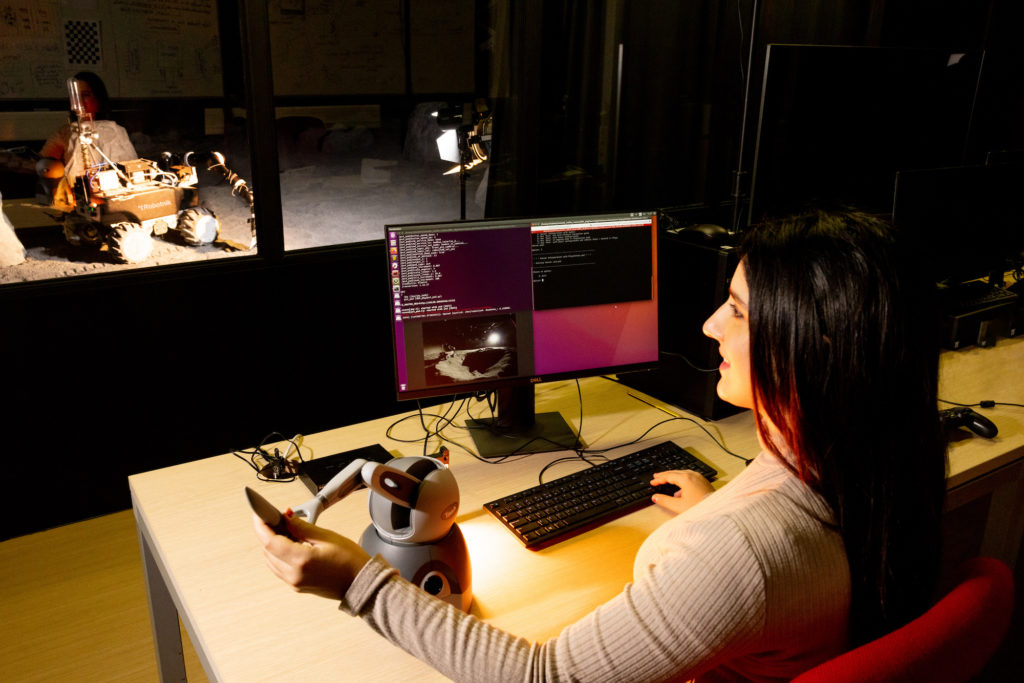As countries and companies worldwide reach advanced milestones in the new space race and prepare for future missions to the Moon, a number of technical aspects of lunar expeditions have yet to be defined. One of them, connectivity, constitutes a very pressing problem. How will future missions on the Moon communicate with each other, alongside ground stations on Earth?

“Current typical communications in space are point-to-point, meaning they take place between two parties – like a telephone call. But in the upcoming lunar exploration scenarios, multiple crewed and uncrewed missions – including a large number of robots and rovers – will need to communicate with each other,” says Dr. Jorge Querol, head of the SatComLab at SnT.
Relying on current practices for this kind of communication would be limiting and impractical at best, not to mention outright unsustainable with lots of connected devices. For this reason, a group of 15 researchers across the Space Robotics (SpaceR), the Space Systems Engineering (SpaSys) and the Signal Processing and Communications (SIGCOM) at SnT recently launched the 5G Space Communications Lab (5G-SpaceLab), an interdisciplinary, joint experimentation project to simulate 5G-based communications in space and on the Moon.
“5G is perfectly suited to handle a large number of connected devices, and could even constitute a solution for interoperability between different systems and devices on the Moon”
Jorge Querol, SnT Tweet
Leveraging the state-of-the-art space laboratories at SnT – the LunaLab, the Concurrent Design Facility, the CubeSatLab, and the SatComLab – the project simulates three kinds of scenarios: to test Earth-orbiting satellite communications in view of the upcoming 5G standardisation of non-terrestrial networks (NTN) in satellite communications, Earth to Moon 5G-based communications, and Moon-orbiting satellite to Moon surface.
As the next standard for satellite communications – offering greater bandwidth, extremely low latency and point-to-multipoint communication capabilities – 5G represents a great technology for communications on and from the Moon. In addition, “5G is perfectly suited to handle a large number of connected devices, and could even constitute a solution for interoperability between different systems and devices on the Moon,” says Querol, who coordinates the 5G-SpaceLab project.
“At the end of the day, we will have to solve the same connectivity challenges on the Moon that we are solving with 5G on Earth"
Jorge Querol, SnT Tweet
Having begun in September 2020, the project will emulate space and satellite communications, as well as lunar rover control and data collection, through different practical scenarios. These include direct communication between Earth and a lunar lander, communications via a lunar relay satellite, and the connectivity of a large number of rovers to a Moon-orbiting satellite constellation. To do so, the 5G-SpaceLab will reproduce to the highest possible degree the exact conditions of these environments, by introducing delay and making use of the advanced space facilities at SnT. As a practical example, as part of the Earth-Moon communication testing, the joint research team will be controlling rovers in the LunaLab via the emulated 5G network in the SatComLab, directing operations from the Concurrent Design Facility (which serves as the project’s mission control room) using haptic control.

Overall, the two scenarios tested in the project are different aspects of the same problem. “At the end of the day, we will have to solve the same connectivity challenges on the Moon that we are solving with 5G on Earth, especially due to the current demand of bandwidth driven by the increasing number of connected devices and the Internet of Things,” concludes Querol. It’s thanks to projects like the 5G-SpaceLab that countries and commercial ventures might soon be able to establish a presence on the Moon, as well as benefit from advanced satellite communication capabilities from the outset.